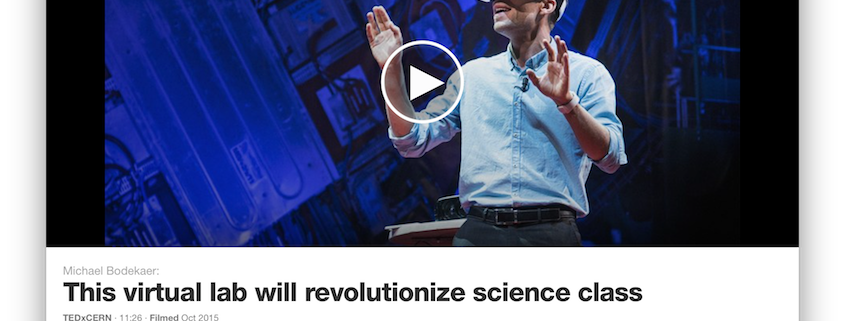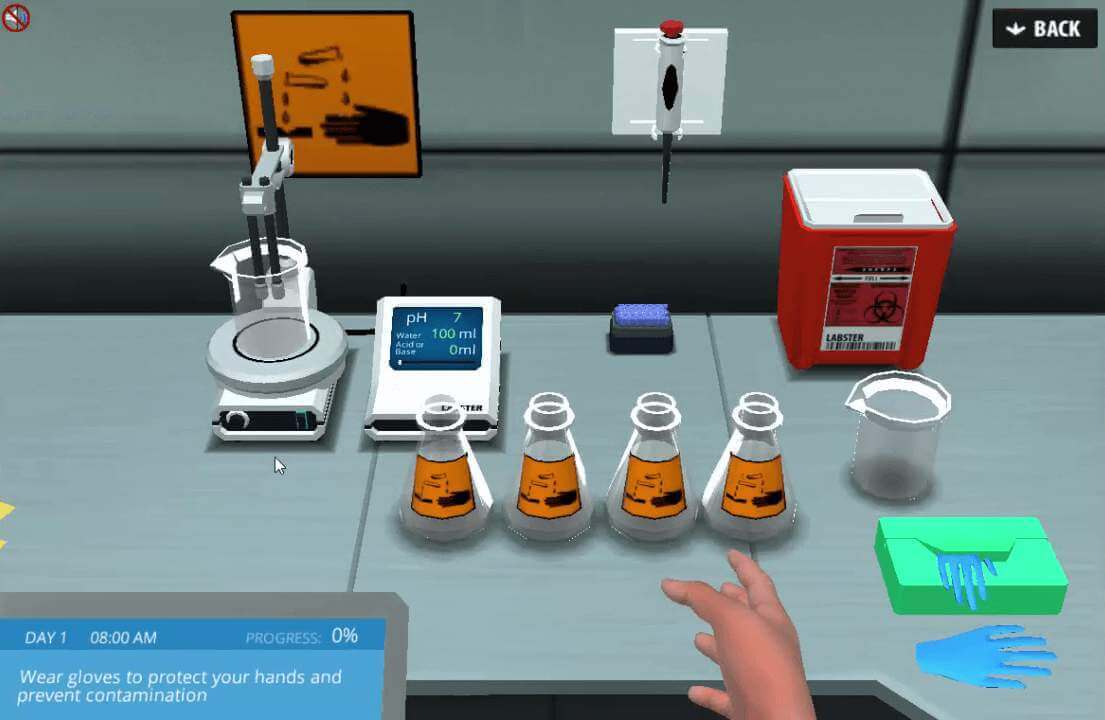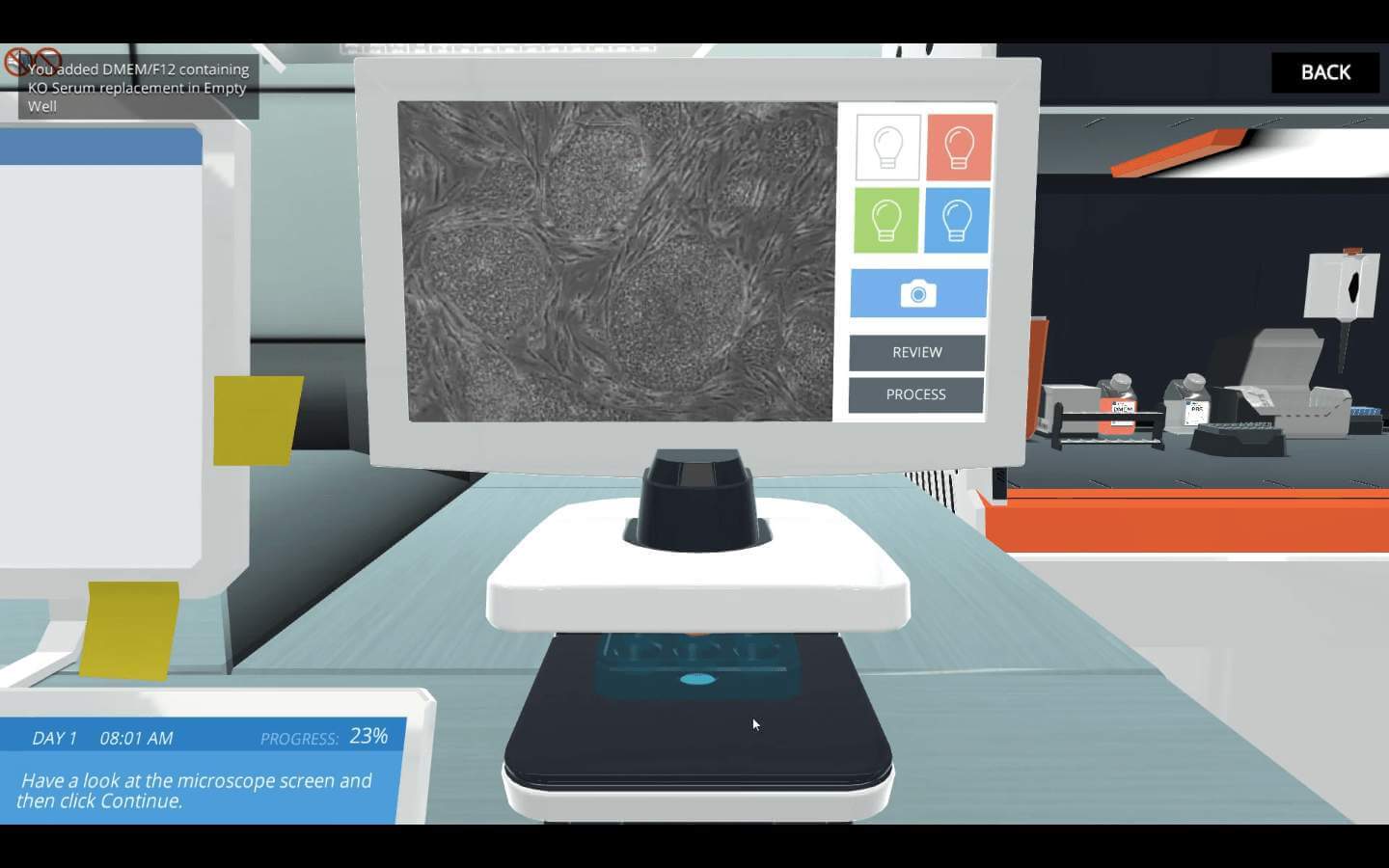Labster – enhancing science learning with VR and gamification
According to the co-founder Michael Bodekaer, Labster will revolutionize science education. This web service, which offers interactive lab simulations, has stirred quite some attention recently – much because of a TED Talk in October 2015.
Crastina’s game editor Nikola Adamus got in touch with Amanda Persi to hear more about an essential part of the concept: the gamification elements of the simulations.
Hi, Amanda, can you tell me about the use of gamification in Labster?
Labster’s vision is to develop virtual laboratory simulations to empower the next generation of scientists to change the world. Gamification is definitely a key point to consider in the development of these simulations. It is well known that being in a “flow” state (described by psychologist Mihály Csíkszenmihályi as a mental state in which the person performing an activity is totally immersed in it) greatly benefits learning.
“This empowers them to progress in the story by understanding what they have done and being fully immersed.”
There are many ways of trying to support this state by enhancing motivation, and one of them is to gamify the experience. In the creation of our simulations, we use tools from gaming theories. For example, storytelling is a big component of all our cases, and we are dedicated to writing compelling stories that are relevant to students’ daily lives. These are stories that they can identify with and in which they can be the “heroes”. Also, the quiz questions that are integrated in the stories act as a “gamification” element, adding the challenges and competition level needed to keep the motivation high, and allowing the implementation of other gamification components such as a reward system. In our simulations you get more points when you find the right answer to a quiz in the first attempt. Another piece that our students have found very rewarding is the fact that they get an explanation of the correct answer immediately after the question is answered correctly. This empowers them to progress in the story by understanding what they have done and being fully immersed.
There are a lot of other gamification “tricks” that we aim to explore. For example, the idea of incorporating prizes that the people you help with your research will give to you. That could include a picture that you can put on the fridge of your lab of a baby that is healthy thanks to your help in prenatal diagnosis. Other prizes could include the ability to unlock new stories, or to perform more complicated experiments.
One very important aspect of gaming is the social component. Some ideas are simple, like being able to share badges or accomplishments in the lab with your social network (one of the keys of success of games like Candy Crush); or more complex scenarios where collaboration between different “players” is needed to solve the mystery, perform the right experiment, or get all the data needed to finalize the quest (similar to the teamwork needed in games like League of Legends).
How well does it improve the performance?
Since we develop simulations to teach science, we have a very scientific approach to learning. At Labster, we are committed to high quality research to investigate the impact of our simulations in learning outcomes (students’ performance measurement), and what we can do to enhance them.
• In our Nature Biotechnology paper in 2014, part of our CEO’s PhD thesis, we demonstrated that using only our laboratory simulations led to significantly improved learning outcomes (76% higher scores) compared with traditional teaching. When a traditional lecture and the simulation were combined, the measured learning outcomes were greater than any of the methods alone. In addition, we showed that more than 80% of the students agreed or strongly agreed with the Labster simulation being more motivating than ordinary exercises. They also said it made the course more interesting in working with practical examples and that they were inspired by Labster simulations to work with laboratory analysis.
• In another study published in BMC Medical Education researchers utilized our simulations with medical students, concluding that our simulation based learning environment increased students’ learning, intrinsic motivation, and self-efficacy. The results suggest that simulations can help future generations of doctors transfer new understanding of disease mechanisms gained in virtual laboratory settings into everyday clinical practice.
• Another study done at Glasgow university using our simulations concluded that they are as effective as face-to-face tutorials in preparing students for a physical lab activity in microbiology, which is incredible important because pre-lab preparation is an important predictor of success in lab exercises, and most importantly, it allows the teachers to spend quality time with the students in the lab which has an even greater impact in their performance.
Do you think that gamification should be widely used not only in research but elsewhere?
We think that motivation is key for learning. If you are motivated you will learn better and work better. If you are motivated, you can achieve things you never thought you could, and they main advantage of games is that they are powerful tools that help in keeping people’s motivation high.
One field that has benefited a lot from a gamification approach is health care. For example Superbetter is a game that has been proven to help reducing symptoms of anxiety and depression. Or the impact of the recently launched Pokemon Go has had on people with depression; this is a game that wasn’t even designed with that purpose in mind.
A lot of companies are also using this approach to boost the motivation of their employees, and even for training purposes. For example, we use our simulations for onboarding new content writers. Their first week they have to play the “writers’ training simulation” and we have a mini-game to link pictures and names of all the team members so we can all get to know each other. It is a bit of a challenge as the company is growing rapidly and we have remote teams working all over the world – but it’s a lot of fun!
What does science communication mean for you? Do you think that simulations are beneficial for effective science communication?

Illustration of student evaluations of the simulations impact on their understanding of the translation from diagnosis into everyday clinical practice and health decision-making
Science communication is a very general term that incorporates all the activities dedicated to bringing science out of the labs and research centers. It can include: writing scientific papers to share findings with the rest of the research community; an outreach event organized by a museum to explain to kids how a spaceship can go to the moon; or even a science lesson at school. However, the term science communication normally refers to the communication of scientific findings and facts to the non-scientific population. Under any definition, we think that laboratory simulations are a great way of bringing science closer to people. ‘Presence’ has been described as a crucial element for motivation and engagement, and simulations intrinsically enhance the aspect of “I feel that I am there”, especially if they are combined with virtual reality technologies. In the particular case of our simulations, even if they are specifically created as teaching tools, in addition to the immersive experience, they are built around real life stories and are meant to be engaging. With the gamification components they are also good tools for science communication at some level.
You cooperate with many countries, can you tell me about differences when it comes to science communication, the use of gamification in such diversified community?
In our experience, the science and the basic gamification techniques that we are using are very universal and well researched around the world. For example, in general everyone likes to be part of a story that they can understand and relate to. However, this can also be the source of some challenges; a particular narrative can be very relevant for some communities and less so for others. Being aware and sensitive to these differences is really important, and getting the balance right is sometimes difficult, but we work directly with teachers all over the world to ensure the content is as relevant for their students as possible.
Labster – a virtual wet lab
Labster was founded by the Danish tech entrepreneurs Mads T. Bonde and Michael Bodekaer. Their vision is to make advanced science education more accessible by offering virtual wet lab environments where students can simulate the use of modern lab equipment like chromatographs, PCR and Next Generation Sequencing.
Michael Bodekaer recently presented the concept in a TED talk.
- Labster – enhancing science learning with VR and gamification - August 8, 2016
- 3 tips to improve your networking skills—advice from an international student - January 14, 2016
- Interview with Carla Brown — creator of Bacteria Combat game - November 30, 2015
- The (non-)necessity of PowerPoint – a personal reflection - October 29, 2015
- How to be convincing in three minutes - October 16, 2015







Leave a Reply
Want to join the discussion?Feel free to contribute!